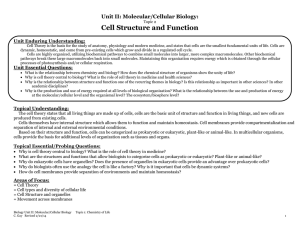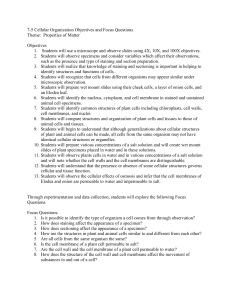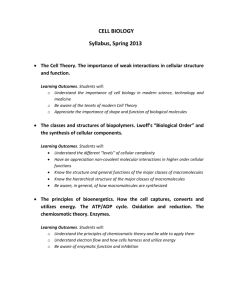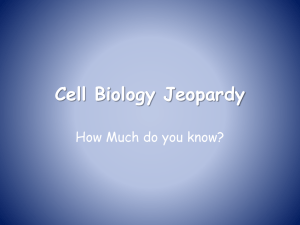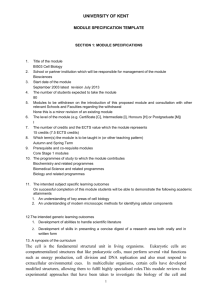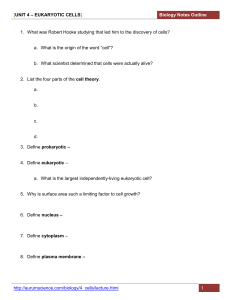HANOPHY.LessonPlan.CastleTop
advertisement
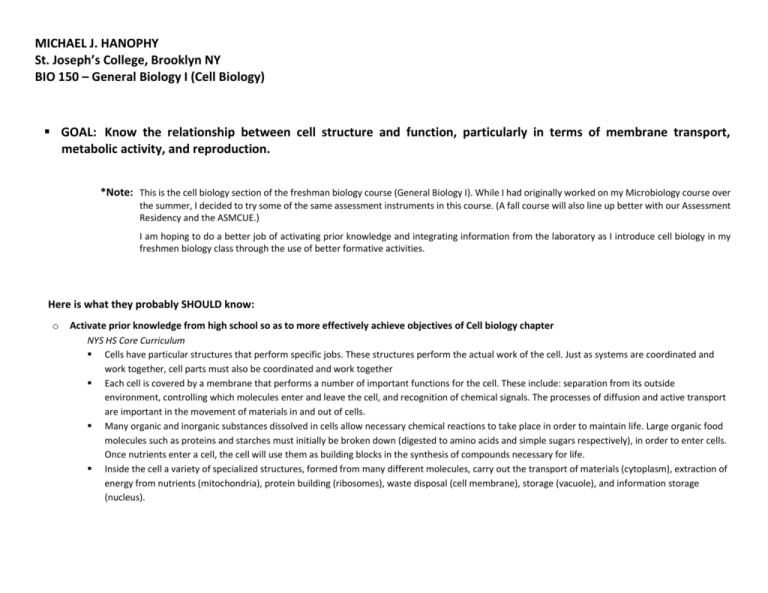
MICHAEL J. HANOPHY St. Joseph’s College, Brooklyn NY BIO 150 – General Biology I (Cell Biology) GOAL: Know the relationship between cell structure and function, particularly in terms of membrane transport, metabolic activity, and reproduction. *Note: This is the cell biology section of the freshman biology course (General Biology I). While I had originally worked on my Microbiology course over the summer, I decided to try some of the same assessment instruments in this course. (A fall course will also line up better with our Assessment Residency and the ASMCUE.) I am hoping to do a better job of activating prior knowledge and integrating information from the laboratory as I introduce cell biology in my freshmen biology class through the use of better formative activities. Here is what they probably SHOULD know: o Activate prior knowledge from high school so as to more effectively achieve objectives of Cell biology chapter NYS HS Core Curriculum Cells have particular structures that perform specific jobs. These structures perform the actual work of the cell. Just as systems are coordinated and work together, cell parts must also be coordinated and work together Each cell is covered by a membrane that performs a number of important functions for the cell. These include: separation from its outside environment, controlling which molecules enter and leave the cell, and recognition of chemical signals. The processes of diffusion and active transport are important in the movement of materials in and out of cells. Many organic and inorganic substances dissolved in cells allow necessary chemical reactions to take place in order to maintain life. Large organic food molecules such as proteins and starches must initially be broken down (digested to amino acids and simple sugars respectively), in order to enter cells. Once nutrients enter a cell, the cell will use them as building blocks in the synthesis of compounds necessary for life. Inside the cell a variety of specialized structures, formed from many different molecules, carry out the transport of materials (cytoplasm), extraction of energy from nutrients (mitochondria), protein building (ribosomes), waste disposal (cell membrane), storage (vacuole), and information storage (nucleus). o Better integrate information from our introductory microscope lab into the cell biology chapter Covered in introductory microscope lab pertinent to cell biology chapter Observe differences in size between prokaryotic and eukaryotic cells under oil immersion Observe cell membrane, cytosol, nucleus, perhaps nucleolus in human squamous epithelial cells Observe chloroplasts, cell wall in Elodea Observe action of cilia/flagella in Trichonympha, Volvox Observe cellular organization in unicellular/colonial/multicellular green algae MON 9/14 TUE 9/15 Read Sec. 6.2-6.4 Pre-Quiz 1 LECTURE 1 LECTURE 2 LECTURE 3 Prior Knowledge Activity A Formative Assess A Formative Assess B Prior Knowledge Activity B Prior Knowledge Activity C WED 9/16 THU 8/17 FRI 9/18 SAT/ SUN Read Sec. 6.5-6.7 MON 9/21 TUE 9/22 Read Sec. 7.1 Pre-Quiz 2 WED 9/23 EXAM #1 THU 9/24 FRI 9/25 SAT/ SUN Sample Exam Essays MON 9/28 LECTURE 1 OBJECTIVE Compare and contrast prokaryotic and eukaryotic cells OUTCOMES o Students should be able to identify the major similarities and differences between prokaryotic and eukaryotic cells. o Students should be able to recognize the role that membranes play in the structure of cells. OBJECTIVE Understand the role that the nucleus plays in the transmission and expression of genetic information and how its structure and organization contribute to that role. OUTCOMES o Students should be able to explain the structure of the nucleus including its membranes and the organization of genetic material within it. o Students should be able to explain what the nucleolus is and the role that is plays in the production of ribosomes. OBJECTIVE Describe the way that the internal membranes of eukaryotic cells form an endomembrane system that regulates protein traffic and performs metabolic functions. OUTCOMES o Students should be able to identify the organelles of the endomembrane system (SER/RER, Golgi, lysosomes, vacuoles, cell membrane) and explain the function of each. o Students should be able to explain the relationship between these organelles and how membranes and proteins can be transferred between them. LECTURE 2 OBJECTIVE Understand the role that mitochondria and chloroplasts play in energy transformation. OUTCOMES o Students should be able to explain the structure and function of mitochondria and chloroplasts. o Students should be able to describe the endosymbiotic theory as it relates to these organelles. OBJECTIVE Describe the role of the cytoskeleton in cellular organization. OUTCOMES o Students should know the constituent parts of the cytoskeleton. o Students should recognize the flexible nature of the cytoskeleton and its role cellular movement cell organization and movement. LECTURE 3 OBJECTIVE Understand the structure of cellular membranes. OUTCOMES o Students should be able to explain the role that hydrophobic and hydrophilic interactions play in membrane structure. o o Students should be able to describe factors that affect the fluidity of membranes. Students should be able to explain how proteins interact with phospholipids in the cell membrane. “Inner Life of the Cell” *Note: Video to be viewed at the end of the Day 3 to emphasize the dynamic nature of the cell and illustrate the inter-relatedness of subcellular structures. As we go through the video (music only version), it will be paused periodically to have students identify specific cellular structures and functions. Music only version https://youtu.be/B_zD3NxSsD8 Narrated version https://youtu.be/FzcTgrxMzZk



